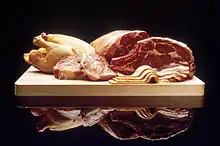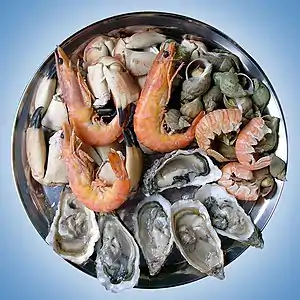American bison
The American bison or simply bison (Bison bison), also commonly known as the American buffalo or simply buffalo, is an American species of bison that once roamed North America in vast herds. Its historical range, by 9000 BC, is described as the great bison belt, a tract of rich grassland that ran from Alaska to the Gulf of Mexico, east to the Atlantic Seaboard (nearly to the Atlantic tidewater in some areas) as far north as New York and south to Georgia and, according to some sources, down to Florida, with sightings in North Carolina near Buffalo Ford on the Catawba River as late as 1750.[2][3][4] It nearly became extinct by a combination of commercial hunting and slaughter in the 19th century and introduction of bovine diseases from domestic cattle. With a population in excess of 60 million in the late 18th century, the species was down to just 541 animals by 1889. Recovery efforts expanded in the mid-20th century, with a resurgence to roughly 31,000[5] wild bison today, largely restricted to a few national parks and reserves. Through multiple reintroductions, the species is now also freely roaming wild in some regions in Yakutia as well as Mexico.[6]
| American bison | |
|---|---|
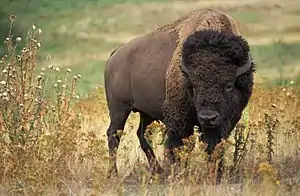 | |
| Plains bison (Bison bison bison) | |
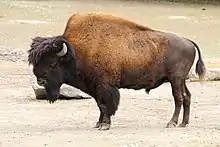 | |
| Wood bison (Bison bison athabascae) | |
| Scientific classification | |
| Kingdom: | Animalia |
| Phylum: | Chordata |
| Class: | Mammalia |
| Order: | Artiodactyla |
| Family: | Bovidae |
| Subfamily: | Bovinae |
| Subtribe: | Bovina |
| Genus: | Bison |
| Species: | B. bison |
| Binomial name | |
| Bison bison | |
| Subspecies | |
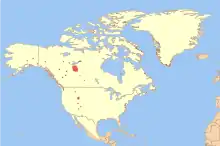 | |
| Synonyms | |
| |
Two subspecies or ecotypes have been described: the plains bison (B. b. bison), smaller in size and with a more rounded hump, and the wood bison (B. b. athabascae)—the larger of the two and having a taller, square hump.[7][8][9][10][11][12] Furthermore, the plains bison has been suggested to consist of a northern plains (B. b. montanae) and a southern plains (B. b. bison) subspecies, bringing the total to three.[10] However, this is generally not supported. The wood bison is one of the largest wild species of extant bovid in the world, surpassed only by the Asian gaur.[13] Among extant land animals in North America, the bison is the heaviest and the longest, and the second tallest after the moose.
Spanning back many millennia, Native American tribes have had cultural and spiritual connections to the American bison. It is the national mammal of the United States of America.
Etymology
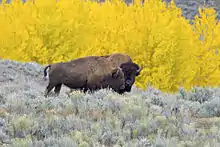
The term buffalo is sometimes considered to be a misnomer for this animal, and could be confused with "true" buffalos, the Asian water buffalo and the African buffalo. However, the name buffalo is listed in many dictionaries as an acceptable name for American buffalo or bison. Samuel de Champlain applied the term buffalo (buffles in French) to the bison in 1616 (published 1619), after seeing skins and a drawing shown to him by members of the Nipissing First Nation, who said they travelled forty days (from east of Lake Huron) to trade with another nation who hunted the animals.[14] In English usage, the term buffalo dates to 1625 in North America, when the term was first recorded for the American mammal.[15] It thus has a much longer history than the term bison, which was first recorded in 1774.[16] The American bison is very closely related to the European bison (also known as wisent or the European wood bison).
In Plains Indian languages in general, male and female buffaloes are distinguished, with each having a different designation rather than there being a single generic word covering both sexes. Thus:
- in Arapaho: bii (buffalo cow), henéécee (buffalo bull)
- in Lakota: pté (buffalo cow), tȟatȟáŋka (buffalo bull)
Such a distinction is not a general feature of the language (for example, Arapaho possesses gender-neutral terms for other large mammals such as elk, mule deer, etc.), and so presumably is due to the special significance of the buffalo in Plains Indian life and culture.
Description
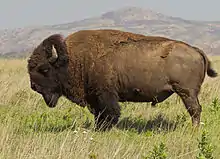
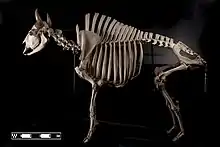
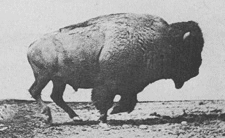
A bison has a shaggy, long, dark-brown winter coat, and a lighter-weight, lighter-brown summer coat. Male bison are significantly larger and heavier than females. Wood bison is potentially more primitive in phenotype than plains bison while the latter probably evolved from mixing of Bison occidentalis and Bison antiquus.[17] Plains bison are often in the smaller range of sizes, and wood bison in the larger range. Head-rump lengths at maximum up to 3.5 m (11 ft 6 in) for males and 2.85 m (9 ft 4 in) for females long and the tail adding 30 to 95 cm (1 ft 0 in to 3 ft 1 in).[17][18][19] Heights at withers in the species can reach up to 186 to 201 cm (6 ft 1 in to 6 ft 7 in) for B. b. bison and B. b. athabascae respectively.[19] Typically weights can range from 318 to 1,179 kg (701 to 2,599 lb),[19][20][21][22] 460 to 988 kg (1,014 to 2,178 lb) with medians of 730 to 792.5 kg (1,609 to 1,747 lb) (B.b. bison) and 943.6 kg (2,080 lb) (B.b.athabascae) in males, and 360 to 640 kg (790 to 1,410 lb) with medians of 450 to 497.6 kg (992 to 1,097 lb) in females,[17] although the lowest weights probably representing typical weight around the age of sexual maturity at 2 to 3 years of age.[23][24][25][26][27][17] The heaviest wild bull for B.b.bison ever recorded weighed 1,270 kg (2,800 lb)[28] while there had been bulls estimated to be 1,360 kg (3,000 lb).[29] B.b.athabascae is significantly larger and heavier on average than B.b.bison while the number of recorded samples for the former was limited after the rediscovery of a relatively pure herd.[17] Elk Island National Park, which has wild populations of both wood and plains bison, has recorded maximum weights for bull bison of 1186 kg (plains) and 1099 kg (wood), but noted that 3/4 of all bison over 1000kg were wood bison. When raised in captivity and farmed for meat, the bison can grow unnaturally heavy and the largest semidomestic bison weighed 1,724 kg (3,801 lb).[20] The heads and forequarters are massive, and both sexes have short, curved horns that can grow up to 60 cm (2 ft) long with 90 cm (3 ft) to 124 cm (4 ft) width,[30][29] which they use in fighting for status within the herd and for defense.
Bison are herbivores, grazing on the grasses and sedges of the North American prairies. Their daily schedule involves two-hour periods of grazing, resting, and cud chewing, then moving to a new location to graze again. Sexually mature young bulls may try to start mating with cows by the age of two or three years, but if more mature bulls are present, they may not be able to compete until they reach five years of age.
For the first two months of life, calves are lighter in color than mature bison. One very rare condition is the white buffalo, in which the calf turns entirely white.
Evolution
The bovine family (taurids and bisonids) diverged from the common ancestral line with water buffalo and African buffalo about 5 to 10 million years ago.[31] Thereafter, the family lineage of bison and taurine cattle does not appear to be a straightforward "tree" structure as is often depicted in much evolution, because evidence exists of interbreeding and crossbreeding between different species and members within this family, even many millions of years after their ancestors separated into different species. This cross breeding was not sufficient to conflate the different species back together, but it has resulted in unexpected relationships between many members of this group, such as yak being related to American bison, when such relationships would otherwise not be apparent.
A 2003 study of mitochondrial DNA indicated four distinct maternal lineages in subtribe Bovina:
However, Y chromosome analysis associated wisent and American bison.[33] An earlier study using amplified fragment length polymorphism fingerprinting showed a close association of wisent and American bison and probably with yak, but noted that the interbreeding of Bovini species made determining relationships problematic.[34] It is shown, however, the wisent may have emerged by species divergence initiated by the introgression of bison bulls in a separate ancestral species,[35] the aurochs.[36]
.jpg.webp)

The steppe bison (Bison priscus) diverged from the lineage that led to cattle (Bos taurus) about 2 to 5 million years ago. The bison genus is clearly in the fossil record by 2 million years ago.[21] The steppe bison spread across Eurasia and was the bison that was pictured in the ancient cave paintings of Spain and Southern France.
The European bison arose from the steppe bison, without fossil evidence of other ancestral species between the steppe bison and the European bison, though the European bison might have arisen from the lineage that led to American bison if that lineage backcrossed with the steppe bison. Again, the web of relationships is confusing, but some evidence shows the European bison is descended from bison that had migrated from Asia to North America, and then back to Europe, where they crossbred with existing steppe bison.[21] At one point, some steppe bison crossbred with the ancestors of the modern yak. After that cross, a population of steppe bison (Bison priscus) crossed the Bering Land Bridge to North America. Evidence has been found of multiple crossings of bison to and from Asia starting before 500,000 years ago and continuing until at least 220,000 years ago. The steppe bison spread through the northern parts of North America and lived in Eurasia until roughly 11,000 years ago[37] and North America until 4,000 to 8,000 years ago.[21]
Bison latifrons (giant bison or longhorn bison) is thought to have evolved in midcontinent North America from B. priscus, after the steppe bison crossed into North America.[38][39][40] Giant bison (B. latifrons) appeared in the fossil record around 500,000 years ago.[21] B. latifrons was one of many species of North American megafauna which became extinct during the Quaternary extinction event. It is thought to have disappeared some 21,000–30,000 years ago, during the late Wisconsin glaciation.[41]
The B. latifrons species was replaced by the smaller Bison antiquus. B. antiquus appeared in the North American fossil record approximately 250,000 years ago.[42] B. antiquus, in turn, evolved into B. occidentalis, then into the yet smaller B. bison—the modern American bison—some 5,000 to 10,000 years ago.[43][44] Some researchers consider B. occidentalis to be a subspecies of B. antiquus.[45]
Differences from European bison
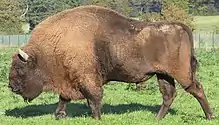
Although they are superficially similar, the American and European bison exhibit a number of physical and behavioral differences. Adult American bison are slightly heavier on average because of their less rangy build, and have shorter legs, which render them slightly shorter at the shoulder.[46] American bison tend to graze more, and browse less than their European relatives, because their necks are set differently. Compared to the nose of the American bison, that of the European species is set farther forward than the forehead when the neck is in a neutral position. The body of the American bison is hairier, though its tail has less hair than that of the European bison. The horns of the European bison point forward through the plane of its face, making it more adept at fighting through the interlocking of horns in the same manner as domestic cattle, unlike the American bison which favors charging.[47] American bison are more easily tamed than the European, and breed more readily with domestic cattle.[48]
Crossbreeding with cattle
During the population bottleneck, after the great slaughter of American bison during the 1800s, the number of bison remaining alive in North America declined to as low as 541. During that period, a handful of ranchers gathered remnants of the existing herds to save the species from extinction. These ranchers bred some of the bison with cattle in an effort to produce "cattalo".[49] Accidental crossings were also known to occur. Generally, male domestic bulls were crossed with buffalo cows, producing offspring of which only the females were fertile. The crossbred animals did not demonstrate any form of hybrid vigor, so the practice was abandoned. The proportion of cattle DNA that has been measured in introgressed individuals and bison herds today is typically quite low, ranging from 0.56 to 1.8%.[49][50] In the United States, many ranchers are now using DNA testing to cull the residual cattle genetics from their bison herds. The U.S. National Bison Association has adopted a code of ethics which prohibits its members from deliberately crossbreeding bison with any other species.
Range and population
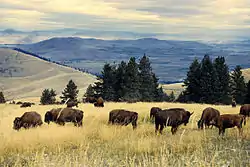
Despite being the closest relatives of domestic cattle native to North America, bison were never domesticated by Native Americans. Later attempts of domestication by Europeans prior to the 20th century met with limited success. Bison were described as having a "wild and ungovernable temper";[51] they can jump close to 1.8 m (6 ft) vertically,[52] and run 55–65 km/h (35–40 mph) when agitated. This agility and speed, combined with their great size and weight, makes bison herds difficult to confine, as they can easily escape or destroy most fencing systems, including most razor wire. The most successful systems involve large, 6-metre (20 ft) fences made from welded steel I beams sunk at least 1.8 m (6 ft) into concrete. These fencing systems, while expensive, require very little maintenance. Furthermore, making the fence sections overlap so the grassy areas beyond are not visible prevents the buffalo from trying to get to new range.
About 500,000 bison currently exist on private lands and around 30,000 on public lands which includes environmental and government preserves.[53] According to the IUCN, roughly 15,000 bison are considered wild, free-range bison not primarily confined by fencing.
The Nature Conservancy (TNC) has reintroduced bison to over a dozen nature preserves around the United States. In October 2016, TNC established the easternmost bison herd in the country, at Kankakee Sands Nature Preserve in Morocco, Newton County, Indiana.[54] In 2014, U.S Tribes and Canadian First Nations signed a treaty to help with the restoration of bison, the first to be signed in nearly 150 years.[55]
Habitat and trails
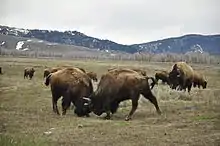
American bison live in river valleys, and on prairies and plains. Typical habitat is open or semiopen grasslands, as well as sagebrush, semiarid lands, and scrublands. Some lightly wooded areas are also known historically to have supported bison. Bison also graze in hilly or mountainous areas where the slopes are not steep. Though not particularly known as high-altitude animals, bison in the Yellowstone Park bison herd are frequently found at elevations above 2,400 m (8,000 ft) and the Henry Mountains bison herd is found on the plains around the Henry Mountains, Utah, as well as in mountain valleys of the Henry Mountains to an altitude of 3,000 m (10,000 ft). Those in Yukon, Canada, typically summer in alpine plateaus above treeline.[56] The first thoroughfares of North America, except for the time-obliterated paths of mastodon or muskox and the routes of the mound builders, were the traces made by bison and deer in seasonal migration and between feeding grounds and salt licks. Many of these routes, hammered by countless hoofs instinctively following watersheds and the crests of ridges in avoidance of lower places' summer muck and winter snowdrifts, were followed by the aboriginal North Americans as courses to hunting grounds and as warriors' paths. They were invaluable to explorers and were adopted by pioneers.
Bison traces were characteristically north and south, but several key east-west trails were used later as railways. Some of these include the Cumberland Gap through the Blue Ridge Mountains to upper Kentucky. A heavily used trace crossed the Ohio River at the Falls of the Ohio and ran west, crossing the Wabash River near Vincennes, Indiana. In Senator Thomas Hart Benton's phrase saluting these sagacious path-makers, the bison paved the way for the railroads to the Pacific.[57]
Mexico
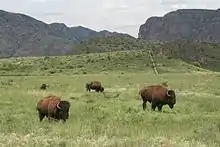
The southern extent of the historic range of the American bison includes northern Mexico and adjoining areas in the United States as documented by archeological records and historical accounts from Mexican archives from 700 CE to the 19th century. The Janos-Hidalgo bison herd has ranged between Chihuahua, Mexico, and New Mexico, United States, since at least the 1920s.[58] The persistence of this herd suggests that habitat for bison is suitable in northern Mexico. In 2009, genetically pure bison were reintroduced to the Janos Biosphere Reserve in northern Chihuahua adding to the Mexican bison population.[59] In 2020, the second herd was formed in Maderas del Carmen.[60]
Siberia
.jpg.webp)
Since 2006, an outherd of wood bison sent from Alberta's Elk Island National Park was established in Yakutia, Russia[61][62][63] as a practice of Pleistocene rewilding; wood bison is the most closely related to the extinct steppe bison. These bison are adapting well in the 6,000 years-ago homeland,[64] and the Yakutia's Red List officially registered the species in 2019, and the second herd was formed in 2020.[65][66]
Behavior and ecology
Bison are migratory and herd migrations can be directional as well as altitudinal in some areas.[67][68][69] Bison have usual daily movements between foraging sites during the summer. In the Hayden Valley, Wyoming, bison have been recorded traveling, on average, 3 km (2 mi) per day.[69] The summer ranges of bison appear to be influenced by seasonal vegetation changes, interspersion and size of foraging sites, the rut, and the number of biting insects.[67] The size of preserve and availability of water may also be a factor.[69] Bison are largely grazers, eating primarily grasses and sedges. On shortgrass pasture, bison predominately consume warm-season grasses.[70] On mixed prairie, cool-season grasses, including some sedges, apparently compose 79–96% of their diet.[71] In montane and northern areas, sedges are selected throughout the year.[67] Bison also drink water or consume snow on a daily basis.[69]
Social behavior and reproduction
.jpg.webp)
Female bison live in maternal herds which include other females and their offspring. Male offspring leave their maternal herd when around three years old and either live alone or join other males in bachelor herds. Male and female herds usually do not mingle until the breeding season, which can occur from July through September.[72] However, female herds may also contain a few older males. During the breeding season, dominant bulls maintain a small harem of females for mating. Individual bulls "tend" cows until allowed to mate, by following them around and chasing away rival males. The tending bull shields the female's vision with his body so she will not see any other challenging males. A challenging bull may bellow or roar to get a female's attention and the tending bull has to bellow/roar back.[73] The most dominant bulls mate in the first 2–3 weeks of the season.[73] More subordinate bulls mate with any remaining estrous cow that has not mated yet. Male bison play no part in raising the young.
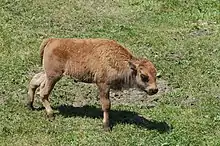
_(1).jpg.webp)
Bison herds have dominance hierarchies that exist for both males and females. A bison's dominance is related to its birth date.[74] Bison born earlier in the breeding season are more likely to be larger and more dominant as adults.[74] Thus, bison are able to pass on their dominance to their offspring as dominant bison breed earlier in the season. In addition to dominance, the older bison of a generation also have a higher fertility rate than the younger ones.[74]
Bison mate in August and September; gestation is 285 days. A single reddish-brown calf nurses until the next calf is born. If the cow is not pregnant, a calf will nurse for 18 months. Cows nurse their calves for at least 7 or 8 months, but most calves seem to be weaned before the end of their first year.[69] At three years of age, bison cows are mature enough to produce a calf. The birthing period for bison in boreal biomes is protracted compared to that of other northern ungulates, such as moose and caribou.[75]
Bison have a life expectancy around 15 years in the wild and up to 25 years in captivity. However, males and females from a hunted population also subject to wolf predation in northern Canada have been reported to live to 22 and 25 years of age, respectively.[76]
Bison have been observed to display homosexual behaviors, males much more so than females. In the case of males, it is unlikely to be related to dominance, but rather to social bonding or gaining sexual experience.[77]
Horning
Bison mate in late spring and summer in more open plain areas. During fall and winter, bison tend to gather in more wooded areas. During this time, bison partake in horning behaviors. They rub their horns against trees, young saplings, and even utility poles. Aromatic trees like cedars and pine seem to be preferred. Horning appears to be associated with insect defense, as it occurs most often in the fall when the insect population is at its highest.[78] Cedar and pines emit an aroma after bison horn them and this seems to be used as a deterrent for insects.[78]
Wallowing behavior
.JPG.webp)
A bison wallow is a shallow depression in the soil, which bison use either wet or dry. Bison roll in these depressions, covering themselves with dust or mud. Past and current hypotheses to explain the purpose of wallowing include grooming associated with shedding, male-male interaction (typically rutting), social behavior for group cohesion, play, relief from skin irritation due to biting insects, reduction of ectoparasite (tick and lice) load, and thermoregulation.[79] Bison wallowing has important ecosystem engineering effects and enhances plant and animal diversity on prairies.[80]
Predation
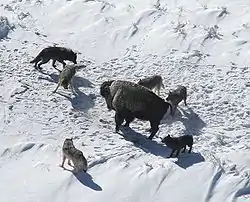
.jpg.webp)
While often secure from predation because of their size and strength, in some areas, vulnerable individuals are regularly preyed upon by wolves. Wolf predation typically peaks in late winter, when elk migrates south and bison are distressed with heavy snows and shortages of food sources,[81] with attacks usually being concentrated on weakened and injured cows and calves.[82][83] Wolves more actively target herds with calves than those without. The length of a predation episode varies, ranging from a few minutes to over nine hours.[84][85] Bison display five apparent defense strategies in protecting calves from wolves: running to a cow, running to a herd, running to the nearest bull, running in the front or center of a stampeding herd, and entering water bodies such as lakes or rivers. When fleeing wolves in open areas, cows with young calves take the lead, while bulls take to the rear of the herds, to guard the cows' escape. Bison typically ignore wolves not displaying hunting behavior.[86] Wolf packs specializing in bison tend to have more males, because their larger size than females allows them to wrestle prey to the ground more effectively.[87] Healthy, mature bulls in herds rarely fall prey.
Grizzly bears are known to feed on carcass and may steal wolves' kills. While grizzlies can also pose a threat to calves and sometimes old, injured, or sick adult bison, direct killing of non-calves is rare even when targeting lone and injured young individuals;[88][89][90] attacking healthy bison is risky for bears, who can be killed instead.[91][92]
Dangers to humans
Bison are among the most dangerous animals encountered by visitors to the various North American national parks and will attack humans if provoked. They appear slow because of their lethargic movements, but can easily outrun humans; bison have been observed running as fast as 65 km/h (40 mph)[93] for 8 km (5 mi).[94]
_to_take_a_photo_at_Yellowstone_National_Park_in_Wyoming.jpg.webp)
Between 1980 and 1999, more than three times as many people in Yellowstone National Park were injured by bison than by bears. During this period, bison charged and injured 79 people, with injuries ranging from goring puncture wounds and broken bones to bruises and abrasions. Bears injured 24 people during the same time. Three people died from the injuries inflicted—one person by bison in 1983, and two people by bears in 1984 and 1986.[95]
Hunting
| Year | American bison (est) |
|---|---|
| Pre-1800 | 60,000,000[96] |
| 1830 | 40,000,000[96] |
| 1840 | 35,650,000[97] |
| 1870 | 5,500,000[96] |
| 1880 | 395,000[97] |
| 1889 | 541 (U.S.)[98] |
| 1900 | 300 (U.S.)[96] |
| 1944–47 | 5,000 (U.S.)[99] |
| 15,000 (Canada)[97] | |
| 1951 | 23,340[100] |
| 2000 | 360,000 |
Buffalo hunting, i.e. hunting of the American bison, was an activity fundamental to the Indigenous peoples of the Great Plains. This activity was later adopted by American professional hunters, as well as by the U.S. government, in an effort to sabotage the central resource of some American Indian Nations during the later portions of the American Indian Wars, leading to the near-extinction of the species around 1890.[101] For many tribes the buffalo was an integral part of life—something guaranteed to them by the Creator. In fact, for some Plains indigenous peoples, bison are known as the first people.[102] The concept of species extinction was foreign to many tribes.[103] Thus, when the U.S. government began to massacre the buffalo, it was particularly harrowing to the Indigenous people. As Crow chief Plenty Coups described it: "When the buffalo went away the hearts of my people fell to the ground, and they could not lift them up again. After this nothing happened. There was little singing anywhere."[104] Spiritual loss was rampant; bison were an integral part of traditional tribal societies and they would frequently take part in ceremonies for each bison they killed to honor its sacrifice. In order to boost morale during this time, Sioux and other tribes took part in the Ghost Dance, which consisted of hundreds of people dancing until 100 persons were lying unconscious.[105]
Today, many conservation measures have been taken by Native Americans with the Inter Tribal Bison Council being one of the most significant. It was formed in 1990, composed of 56 tribes in 19 states.[106] These tribes represent a collective herd of more than 15,000 bison and focus on reestablishing herds on tribal lands in order to promote culture, revitalize spiritual solidarity, and restore the ecosystem. Some Inter Tribal Bison Council members argue that the bison's economic value is one of the main factors driving its resurgence. Bison serve as a low cost substitute for cattle, and can withstand the winters in the Plains region far easier than cattle.[106]
 Bison being chased off a cliff as "seen" and painted by Alfred Jacob Miller
Bison being chased off a cliff as "seen" and painted by Alfred Jacob Miller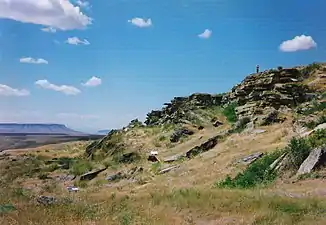
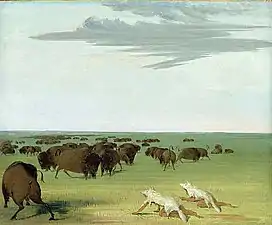 Bison hunt under the wolf-skin mask, 1832–33
Bison hunt under the wolf-skin mask, 1832–33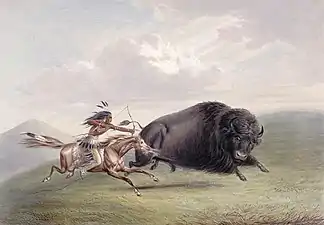 A bison hunt depicted by George Catlin
A bison hunt depicted by George Catlin
As livestock

Bison are increasingly raised for meat, hide, wool, and dairy products. The majority of American bison in the world are raised for human consumption or fur clothing. Bison meat is generally considered to taste very similar to beef, but is lower in fat and cholesterol, yet higher in protein than beef,[108] which has led to the development of beefalo, a fertile hybrid of bison and domestic cattle.[109] In 2005, about 35,000 bison were processed for meat in the U.S., with the National Bison Association and USDA providing a "Certified American Buffalo" program with birth-to-consumer tracking of bison via RFID ear tags. A market even exists for kosher bison meat; these bison are slaughtered at one of the few kosher mammal slaughterhouses in the U.S., and the meat is then distributed nationwide.
Bison are found in publicly and privately held herds. Custer State Park in South Dakota is home to 1,500 bison, one of the largest publicly held herds in the world, but some question the genetic purity of the animals. Wildlife officials believe that free roaming and genetically pure herds on public lands in North America can be found only in the Yellowstone Park bison herd,[110] the Henry Mountains bison herd at the Book Cliffs and Henry Mountains in Utah, at Wind Cave National Park in South Dakota, Fort Peck Indian Reservation in Montana, Mackenzie Bison Sanctuary in the Northwest Territories, Elk Island National Park and Wood Buffalo National Park in Alberta, and Prince Albert National Park in Saskatchewan. Another population, the Antelope Island bison herd on Antelope Island in Utah, consisting of 550 to 700 bison, is also one of the largest and oldest public herds in the United States, but the bison in that herd are considered to be only semifree roaming, since they are confined to the Antelope Island. In addition, recent genetic studies indicate that, like most bison herds, the Antelope Island bison herd has a small number of genes from domestic cattle. In 2002, the United States government donated some bison calves from South Dakota and Colorado to the Mexican government. Their descendants live in the Mexican nature reserves El Uno Ranch at Janos and Santa Elena Canyon, Chihuahua, and Boquillas del Carmen, Coahuila, located near the southern banks of the Rio Grande, and around the grassland state line with Texas and New Mexico.
Recent genetic studies of privately owned herds of bison show that many of them include animals with genes from domestic cattle.[110] For example, the herd on Santa Catalina Island, California, isolated since 1924 after being brought there for a movie shoot, were found to have cattle introgression.[111] As few as 12,000 to 15,000 pure bison are estimated to remain in the world. The numbers are uncertain because the tests used to date—mitochondrial DNA analysis—indicate only if the maternal line (back from mother to mother) ever included domesticated bovines, thus say nothing about possible male input in the process. Most hybrids were found to look exactly like purebred bison; therefore, appearance is not a good indicator of genetics.
The size of the Canadian domesticated herd (genetic questions aside) grew dramatically through the 1990s and 2000s. The 2006 Census of Agriculture reported the Canadian herd at 195,728 head, a 34.9% increase since 2001.[112] Of this total, over 95% was located in Western Canada, and less than 5% in Eastern Canada. Alberta was the province with the largest herd, accounting for 49.7% of the herd and 45.8% of the farms. The next-largest herds were in Saskatchewan (23.9%), Manitoba (10%), and British Columbia (6%). The main producing regions were in the northern parts of the Canadian prairies, specifically in the parkland belt, with the Peace River region (shared between Alberta and British Columbia) being the most important cluster, accounting for 14.4% of the national herd.[112] Canada also exports bison meat, totaling 2,075,253 kilograms (4,575,150 lb) in 2006.[113]
A proposal known as Buffalo Commons has been suggested by a handful of academics and policymakers to restore large parts of the drier portion of the Great Plains to native prairie grazed by bison. Proponents argue that current agricultural use of the shortgrass prairie is not sustainable, pointing to periodic disasters, including the Dust Bowl, and continuing significant human population loss over the last 60 years. However, this plan is opposed by some who live in the areas in question.[110]
Genetics
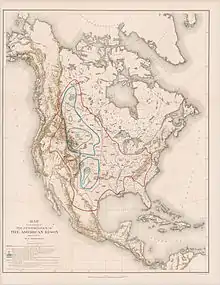
A major problem that bison face today is a lack of genetic diversity due to the population bottleneck the species experienced during its near-extinction event. Another genetic issue is the entry of genes from domestic cattle into the bison population, through hybridization.[110]
Officially, the "American buffalo" is classified by the United States government as a type of cattle, and the government allows private herds to be managed as such. This is a reflection of the characteristics that bison share with cattle. Though the American bison is not only a separate species, but also is usually regarded as being in a separate genus from domestic cattle (Bos taurus), they clearly have a lot of genetic compatibility and American bison can interbreed with cattle, although only the female offspring are fertile in the first generation. These female hybrids can be bred back to either bison or domestic bulls, resulting in either 1/4 or 3/4 bison young. Female offspring from this cross are also fertile, but males are not reliably fertile unless they are either 7⁄8 bison or 7⁄8 domestic.[114] Moreover, when they do interbreed, crossbreed animals in the first generation tend to look very much like purebred bison, so appearance is completely unreliable as a means of determining what is a purebred bison and what is a crossbred cow. Many ranchers have deliberately crossbred their cattle with bison, and some natural hybridization could be expected in areas where cattle and bison occur in the same range. Since cattle and bison eat similar food and tolerate similar conditions, they have often been in the same range together in the past, and opportunity for crossbreeding may sometimes have been common.
In recent decades, tests were developed to determine the source of mitochondrial DNA in cattle and bison, and most private "buffalo" herds were actually crossbred with cattle, and even most state and federal buffalo herds had some cattle DNA. With the advent of nuclear microsatellite DNA testing, the number of herds known to contain cattle genes has increased. Though about 500,000 bison exist on private ranches and in public herds, perhaps only 15,000 to 25,000 of these bison are pure and not actually bison-cattle hybrids. "DNA from domestic cattle (Bos taurus) has been detected in nearly all bison herds examined to date."[115] Significant public bison herds that do not appear to have hybridized domestic cattle genes are the Yellowstone Park bison herd, the Henry Mountains bison herd, which was started with bison taken from Yellowstone Park, the Wind Cave bison herd, and the Wood Buffalo National Park bison herd and subsidiary herds started from it, in Canada.
A landmark study of bison genetics performed by James Derr of Texas A&M University corroborated this.[116] The Derr study was undertaken in an attempt to determine what genetic problems bison might face as they repopulate former areas, and it noted that bison seem to be adapting successfully, despite their apparent genetic bottleneck. One possible explanation for this might be the small amount of domestic cattle genes that are now in most bison populations, though this is not the only possible explanation for bison success.
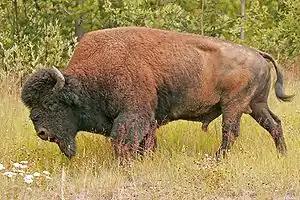
In the study, cattle genes were also found in small amounts throughout most national, state and private herds. "The hybridization experiments conducted by some of the owners of the five foundation herds of the late 1800s, have left a legacy of a small amount of cattle genetics in many of our existing bison herds." He also said, "All of the state owned bison herds tested (except for possibly one) contain animals with domestic cattle mtDNA."[116] It appears that the one state herd that had no cattle genes was the Henry Mountains bison herd; the Henry Mountain herd was started initially with transplanted animals from Yellowstone Park. However, the extension of this herd into the Book Cliffs of central Utah involved mixing the founders with additional bison from another source, so it is not known if the Book Cliffs extension of the herd is also free of cattle hybridization.
A separate study by Wilson and Strobeck, published in Genome, was done to define the relationships between different herds of bison in the United States and Canada, and to determine whether the bison at Wood Buffalo National Park in Canada and the Yellowstone Park bison herd were possibly separate subspecies. The Wood Buffalo Park bison were determined to actually be crossbreeds between plains and wood bison, but their predominant genetic makeup was that of the expected "wood buffalo".[11] However, the Yellowstone Park bison herd was pure plains bison, and not any of the other previously suggested subspecies. Another finding was that the bison in the Antelope Island herd in Utah appeared to be more distantly related to other plains bison in general than any other plains bison group that was tested, though this might be due to genetic drift caused by the small size of only 12 individuals in the founder population. A side finding of this was that the Antelope Island bison herd appears to be most closely related to the Wood Buffalo National Park bison herd, though the Antelope Island bison are actually plains bison.
- Range history of bison in North America
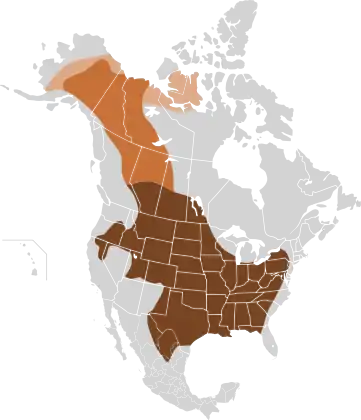 Original distribution of plains bison and wood bison in North America along the "great bison belt". Holocene bison (Bison occidentalis) is an earlier species at the origin of plains bison and wood bison.Holocene bisonWood bisonPlains bison
Original distribution of plains bison and wood bison in North America along the "great bison belt". Holocene bison (Bison occidentalis) is an earlier species at the origin of plains bison and wood bison.Holocene bisonWood bisonPlains bison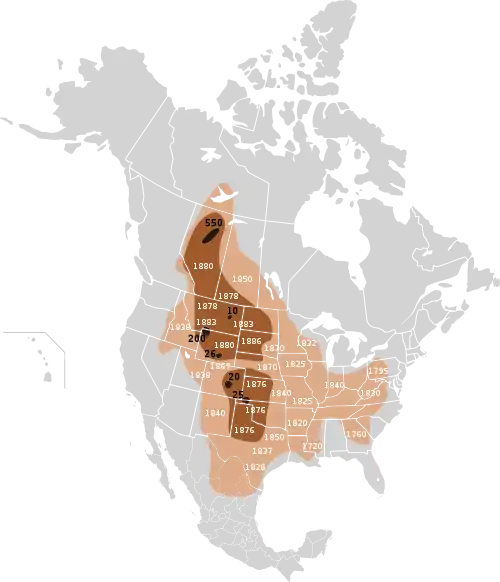 Map of the extermination of the bison to 1889. This map based on William Temple Hornaday's late-19th century research.Original rangeRange as of 1870Range as of 1889
Map of the extermination of the bison to 1889. This map based on William Temple Hornaday's late-19th century research.Original rangeRange as of 1870Range as of 1889 Distribution of public herds of plains bison and of free-ranging or captive breeding wood bison in North America as of 2003.Wood bisonPlains bison
Distribution of public herds of plains bison and of free-ranging or captive breeding wood bison in North America as of 2003.Wood bisonPlains bison
In order to bolster the genetic diversity of the American bison, the National Park Service alongside the Department of the Interior announced on May 7, 2020, the 2020 Bison Conservation Initiative. This initiative focuses on maintaining the genetic diversity of the metapopulation rather than individual herds. Small populations of bison are at considerably larger risk due to their decreased gene pool and are susceptible to catastrophic events more so than larger herds. The 2020 Bison Conservation Initiative aims to translocate up to three bison every five to ten years between the Department of the Interior’s herds. Specific smaller herds will require a more intense management plan. Translocated bison will also be screened for any health defects such as infection of brucellosis bacteria as to not put the larger herd at risk.[117]
As a symbol
Native Americans
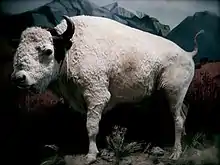
Among many Native American tribes, especially the Plains Indians, the bison is considered a sacred animal and religious symbol. According to University of Montana anthropology and Native American studies professor S. Neyooxet Greymorning, "The creation stories of where buffalo came from put them in a very spiritual place among many tribes. The buffalo crossed many different areas and functions, and it was utilized in many ways. It was used in ceremonies, as well as to make tipi covers that provided homes for people, utensils, shields, weapons and parts were used for sewing with the sinew."[118] The Sioux consider the birth of a white buffalo to be the return of White Buffalo Calf Woman, their primary cultural prophet and the bringer of their "Seven Sacred Rites". Among the Mandan and Hidatsa, the White Buffalo Cow Society was the most sacred of societies for women.
North America
The American bison is often used in North America in official seals, flags, and logos. In 2016, the American bison became the national mammal of the United States.[119] The bison is a popular symbol in the Great Plains states: Kansas, Oklahoma, and Wyoming have adopted the animal as their official state mammal, and many sports teams have chosen the bison as their mascot. In Canada, the bison is the official animal of the province of Manitoba and appears on the Manitoba flag. It is also used in the official coat of arms of the Royal Canadian Mounted Police.
Several American coins feature the bison, most famously on the reverse side of the "buffalo nickel" from 1913 to 1938. In 2005, the United States Mint coined a nickel with a new depiction of the bison as part of its "Westward Journey" series. The Kansas and North Dakota state quarters, part of the "50 State Quarter" series, each feature bison. The Kansas state quarter has only the bison and does not feature any writing, while the North Dakota state quarter has two bison. The Montana state quarter prominently features a bison skull over a landscape. The Yellowstone National Park quarter also features a bison standing next to a geyser.
Other institutions which have adopted the bison as a symbol or mascot include:
- U.S. Department of the Interior
- Bethany College (West Virginia)
- Bucknell University and its athletic program, the Bucknell Bison
- Buffalo, New York
- Buffalo Bills
- Buffalo Bisons
- Buffalo Grove High School
- Buffalo Sabres
- University of Colorado and its athletic program, the Colorado Buffaloes
- Gallaudet University
- Harding University and its athletic program, the Harding Bisons
- Howard University and its athletic program, the Howard Bison
- Seal of the State of Indiana
- Lipscomb University and its athletic program, the Lipscomb Bisons
- Coat of arms of Manitoba
- Flag of Manitoba
- University of Manitoba and its athletic program, the Manitoba Bisons
- Marshall University and its athletic program, the Marshall Thundering Herd
- Milligan College
- Independence Party of Minnesota
- Ralph Nader (mascot for his 2008 campaign for president)[120]
- Nichols College
- North Dakota State University and its athletic program, the North Dakota State Bison
- Oklahoma Baptist University and its athletic program, the Oklahoma Baptist Bison
- Point Park University
- Royal Canadian Mounted Police
- Rumble the Bison (the official mascot of the Oklahoma City Thunder)
- Smoky Hill High School
- Southwestern Law School
- CFB Wainwright
- West Texas A&M University and its athletic program, the West Texas A&M Buffaloes
- Regional Municipality of Wood Buffalo
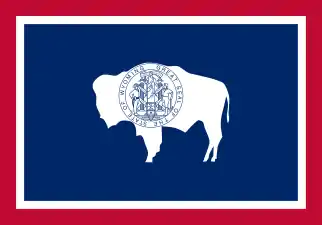 Wyoming uses a bison in its state flag
Wyoming uses a bison in its state flag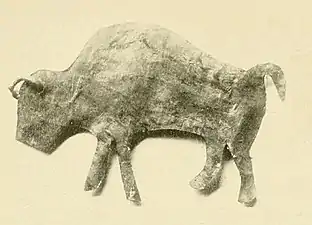
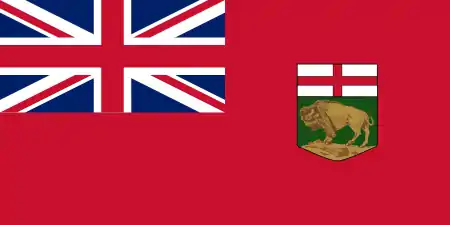 Manitoba uses a bison in its provincial flag, as seen inside the Manitoban coat of arms
Manitoba uses a bison in its provincial flag, as seen inside the Manitoban coat of arms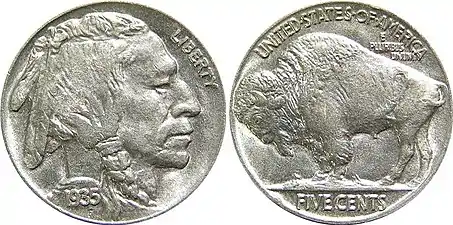 The 1935 Buffalo nickel—this style of coin featuring an American bison was produced from 1913 to 1938
The 1935 Buffalo nickel—this style of coin featuring an American bison was produced from 1913 to 1938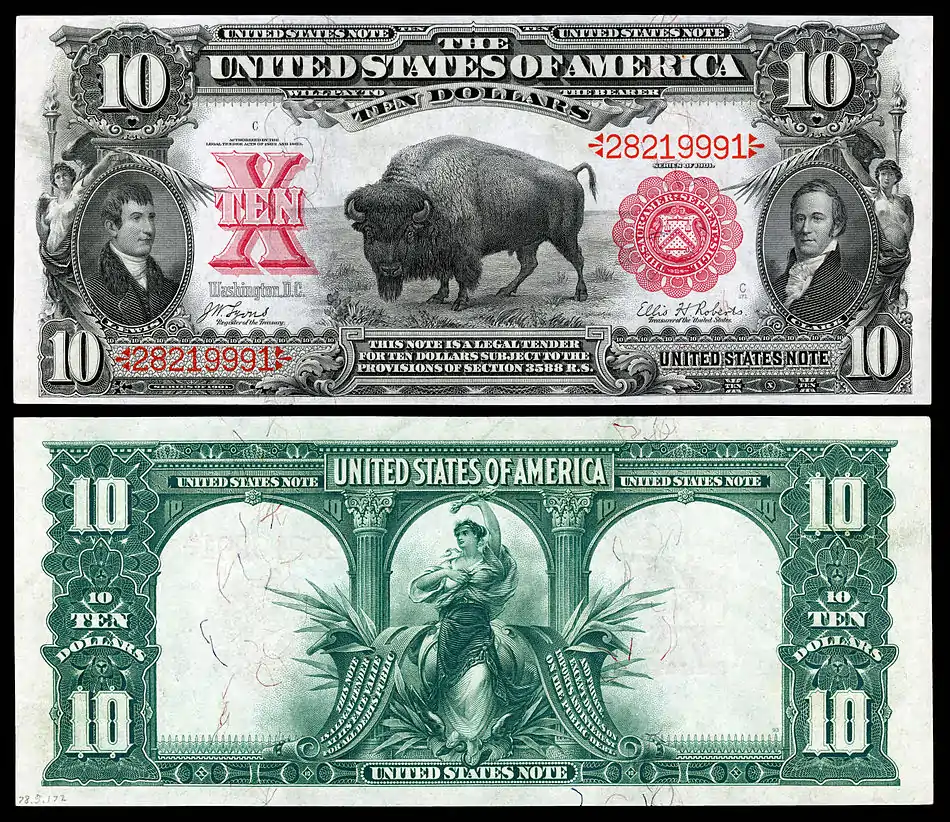 Series 1901 $10 legal tender depicting military explorers Meriwether Lewis, William Clark, and an American bison
Series 1901 $10 legal tender depicting military explorers Meriwether Lewis, William Clark, and an American bison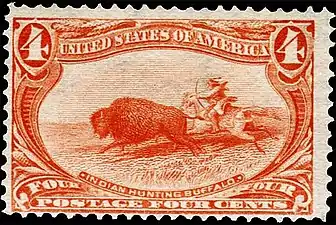 First postage stamp with image of bison was issued US in 1898—4¢ "Indian Hunting Buffalo", part of the Trans-Mississippi Exposition commemorative series
First postage stamp with image of bison was issued US in 1898—4¢ "Indian Hunting Buffalo", part of the Trans-Mississippi Exposition commemorative series
See also
- American Bison Society
- Buffalo Commons — proposed multistate nature preserve of Great Plains habitat for American bison
- The Great Plains Ecoregion
- Buffalo Hunters' War
- Plains hide painting
References
- Gates, C. & Aune, K (2008). "Bison bison". IUCN Red List of Threatened Species. 2008. Retrieved November 10, 2008. Database entry includes a brief justification of why this species is "Near Threatened".
- Project Gutenburg E Book – The Extermination of the American Bison
- "American Buffalo (Bison bison) species page". U.S. Fish and Wildlife Service. Retrieved February 24, 2013.
- William T. Hornaday, Superintendent of the National Zoological Park (February 10, 2006) [1889]. The Extermination of the American Bison. Smithsonian Institution. Retrieved on February 24, 2013.
- Aune, K., Jørgensen, D. & Gates, C. 2017. Bison bison (errata version published in 2018). The IUCN Red List of Threatened Species 2017: e.T2815A123789863. https://doi.org/10.2305/IUCN.UK.2017-3.RLTS.T2815A45156541.en. Downloaded on 06 March 2019.
- "Tras un siglo de ausencia el bisonte americano regresó a territorio mexicano". infobae (in Spanish). Infobae. January 8, 2021. Retrieved January 8, 2021.
- Geist V. (1991). "Phantom subspecies: the wood bison, Bison bison "athabascae" Rhoads 1897, is not a valid taxon, but an ecotype". Arctic. 44 (4): 283–300. doi:10.14430/arctic1552.
- Kay, Charles E.; Clifford A. White (2001). "Reintroduction of bison into the Rocky Mountain parks of Canada: historical and archaeological evidence" (PDF). Crossing Boundaries in Park Management: Proceedings of the 11th Conference on Research and Resource Management in Parks and on Public Lands. Hancock, Michigan: George Wright Soc. pp. 143–51. Retrieved December 2, 2009.
- Bork, A. M.; C. M. Strobeck; F. C. Yeh; R. J. Hudson & R. K. Salmon (1991). "Genetic relationship of wood and plains bison based on restriction fragment length polymorphisms" (PDF). Can J Zool. 69 (1): 43–48. doi:10.1139/z91-007. Archived from the original (PDF) on May 10, 2017. Retrieved December 2, 2009.
- Halbert, Natalie D.; Terje Raudsepp; Bhanu P. Chowdhary & James N. Derr (2004). "Conservation Genetic Analysis of the Texas State Bison Herd". Journal of Mammalogy. 85 (5): 924–931. doi:10.1644/BER-029.
- Wilson, G. A. & C. Strobeck (1999). "Genetic variation within and relatedness among wood and plains bison populations". Genome. 42 (3): 483–96. doi:10.1139/gen-42-3-483. PMID 10382295.
- Boyd, Delaney P. (April 2003). Conservation of North American Bison: Status and Recommendations (PDF). University of Calgary. OCLC 232117310. Archived from the original (MS thesis) on September 28, 2007. Retrieved February 23, 2010.
- Garrick, Dorian; Ruvinsky, Anatoly (November 28, 2014). The Genetics of Cattle, 2nd Edition. ISBN 9781780642215.
- Champlain, Samuel, Henry P. Biggar. 1929. The Works of Samuel de Champlain, vol 3. Toronto: Champlain Society. p. 105.
- The American Heritage Dictionary of the English Language, Fifth Edition:
- "Buffalo Facts". Animal Facts Encyclopedia. Retrieved August 11, 2020.
- C. G Van Zyll de Jong , 1986, A systematic study of recent bison, with particular consideration of the wood bison (Bison bison athabascae Rhoads 1898), p.37, National Museum of Natural Sciences
- Halloran F.A., 1960, American Bison Weights and Measurements from the Wichita Mountains Wildlife Refuge, pp.212-218, Proceedings of the Oklahoma Academy of Science (POAS)
- Gennady G. Boeskorov, Olga R. Potapova, Albert V. Protopopov, Valery V. Plotnikov, Larry D. Agenbroad, Konstantin S. Kirikov, Innokenty S. Pavlov, Marina V. Shchelchkova, Innocenty N. Belolyubskii, Mikhail D. Tomshin, Rafal Kowalczyk, Sergey P. Davydov, Stanislav D. Kolesov, Alexey N. Tikhonov, Johannes van der Plicht, 2016, The Yukagir Bison: The exterior morphology of a complete frozen mummy of the extinct steppe bison, Bison priscus from the early Holocene of northern Yakutia, Russia, pp.7, Quaternary International, Vol.406 (June 25, 2016), Part B, pp.94-110
- Meagher, M. (1986). "Bison bison" (PDF). Mammalian Species (266): 1–8. JSTOR 3504019. Archived from the original (PDF) on December 29, 2011.
- McDonald, J., 1981. North American Bison: Their classification and Evolution. University of California Press, Berkeley, Los Angeles, London. 316 pp.
- The Animal Files
- Castelló, J.R. (2016). Bovids of the World: Antelopes, Gazelles, Cattle, Goats, Sheep, and Relatives. Princeton University Press.
- Berger, J., & Peacock, M. (1988). Variability in size-weight relationships of Bison bison. Journal of Mammalogy, 69(3), 618-624.
- Rutberg, A. T. (1984). Birth synchrony in American bison (Bison bison): response to predation or season? Journal of Mammalogy, 65(3), 418-423.
- Rutberg, A. T. (1986). Dominance and its fitness consequences in American bison cows. Behaviour, 96(1), 62-91.
- Roden, C., Vervaecke, H., & Van Elsacker, L. (2005). Dominance, age and weight in American bison males (Bison bison) during non-rut in semi-natural conditions. Applied Animal Behaviour Science, 92(1), 169-177.
- Joel Berger; Carol Cunningham (June 1994). Bison: mating and conservation in small populations. Columbia University Press. p. 162. ISBN 978-0-231-08456-7.
- Legendary Bison Bulls
- William Henry Burt, 1976, A Field Guide to the Mammals: North America North of Mexico, p.224, Houghton Mifflin Harcourt
- "Maternal and Paternal Lineages in Cross-Breeding Bovine Species. Has Wisent a Hybrid Origin?". Mbe.oxfordjournals.org. January 22, 2004. Retrieved May 29, 2013.
- Guo, S.; et al. (2006). "Taxonomic placement and origin of yaks: implications from analyses of mtDNA D-loop fragment sequences". Acta Theriologica Sinica. 26 (4): 325–330. Archived from the original on March 8, 2012.
- Verkaar, EL; Nijman, IJ; Beeke, M; Hanekamp, E; Lenstra, JA (2004). "Maternal and Paternal Lineages in Cross-Breeding Bovine Species. Has Wisent a Hybrid Origin?". Molecular Biology and Evolution. 21 (7): 1165–70. doi:10.1093/molbev/msh064. PMID 14739241.
- Buntjer, J B; Otsen, M; Nijman, I J; Kuiper, M T R; Lenstra, J A (2002). "Phylogeny of bovine species based on AFLP fingerprinting". Heredity. 88 (1): 46–51. doi:10.1038/sj.hdy.6800007. PMID 11813106.
- Verkaar, EL; Nijman, IJ; Beeke, M; Hanekamp, E; Lenstra, JA (2004). "Maternal and Paternal Lineages in Cross-Breeding Bovine Species. Has Wisent a Hybrid Origin?". Molecular Biology and Evolution. 21 (7): 1165–70. doi:10.1093/molbev/msh064. PMID 14739241.
- Soubrier, J.; Gower, G.; Chen, K.; Richards, S. M.; Llamas, B.; Mitchell, K. J.; Ho, S. Y. W.; Kosintsev, P.; Lee, M. S. Y.; Baryshnikov, G.; Bollongino, R.; Bover, P.; Burger, J.; Chivall, D.; Crégut-Bonnoure, E.; Decker, J. E.; Doronichev, V. B.; Douka, K.; Fordham, D. A.; Fontana, F.; Fritz, C.; Glimmerveen, J.; Golovanova, L. V.; Groves, C.; Guerreschi, A.; Haak, W.; Higham, T.; Hofman-Kamińska, E.; Immel, A.; Julien, M.-A.; Krause, J.; Krotova, O.; Langbein, F.; Larson, G.; Rohrlach, A.; Scheu, A.; Schnabel, R. D.; Taylor, J. F.; Tokarska, M.; Tosello, G.; van der Plicht, J.; van Loenen, A.; Vigne, J.-D.; Wooley, O.; Orlando, L.; Kowalczyk, R.; Shapiro, B.; Cooper, A. (2016). "Early cave art and ancient DNA record the origin of European bison". Nature Communications. 7 (13158): 13158. doi:10.1038/ncomms13158. PMC 5071849. PMID 27754477.
- Guthrie, R. D. (1990). Frozen Fauna of the Mammoth Steppe: The Story of Blue Babe. University of Chicago Press: Chicago.
- Bell, C.J.; et al. (2004). "The Blancan, Irvingtonian, and Rancholabrean mammal ages". In Woodburne, M.O. (ed.). Late Cretaceous and Cenozoic Mammals of North America: Biostratigraphy and Geochronology. New York: Columbia Univ. Press. pp. 232–314. ISBN 978-0-231-13040-0.
- Scott, E.; Cox, S.M. (2008). "Late Pleistocene distribution of Bison (Mammalia; Artiodactyla) in the Mojave Desert of Southern California and Nevada". In Wang, X.; Barnes, L.G. (eds.). Geology and Vertebrate Paleontology of Western and Southern North America. Los Angeles: Natural History Museum of Los Angeles County. pp. 359–382.
- Sanders, A.E.; R.E. Weems & L.B. Albright III (2009). "Formalization of the mid-Pleistocene "Ten Mile Hill beds" in South Carolina with evidence for placement of the Irvingtonian–Rancholabrean boundary". In Albright III, L.B. (ed.). Papers on Geology, Vertebrate Paleontology, and Biostratigraphy in Honor of Michael O. Woodburne. Flagstaff: Museum of Northern Arizona. pp. 369–375.
- Kurten, B; Anderson, E (1980). "Order Artiodactyla". Pleistocene mammals of North America (1st ed.). New York: Columbia University Press. pp. 295–339. ISBN 978-0-231-03733-4.
- Jefferson, G. (2001). Rancho la Brea Bison. In: J. Harris (ed), Rancho La Brea: Death Trap and Treasure Trove. Terra 30(2): 33. Los Angeles Natural History Museum Foundation. p. 33.
- Wilson, M.C.; L.V. Hills & B. Shapiro (2008). "Late Pleistocene northward-dispersing Bison antiquus from the Bighill Creek Formation, Gallelli Gravel Pit, Alberta, Canada, and the fate of Bison occidentalis". Canadian Journal of Earth Sciences. 45 (7): 827–59. doi:10.1139/E08-027. S2CID 129131047.
- Lott, Dale F. (2002). American Bison: A Natural History. Berkeley: University of California Press. ISBN 978-0-520-23338-6.
- "Ohio Archaeology Blog: Better Than a Pointed Stick in the Eye – Not Really". Ohio-archaeology.blogspot.com. May 26, 2011. Retrieved May 29, 2013.
- Trophy Bowhunting: Plan the Hunt of a Lifetime and Bag One for the Record Books, by Rick Sapp, Edition: illustrated, published by Stackpole Books, 2006, ISBN 0-8117-3315-7, ISBN 978-0-8117-3315-1
- American Bison: A Natural History, By Dale F. Lott, Harry W. Greene, ebrary, Inc., Contributor Harry W. Greene, Edition: illustrated, Published by University of California Press, 2003 ISBN 0-520-24062-6, ISBN 978-0-520-24062-9
- Newman, Edward and James Edmund Harting (1859). Zoologist: A Monthly Journal of Natural History Published by J. Van Voorst.
- Halbert, N; Gogan, P; Hiebert, R; Derr, J (2007). "Where the buffalo roam: The role of history and genetics in the conservation of bison on U.S. federal lands". Park Science. 24 (2): 22–29.
- Polziehn, R; Strobeck, C; Sheraton, J; Beech, R (1995). "Bovine mtDNA Discovered in North American Bison Populations". Conservation Biology. 9 (6): 1638–1643 (1642). doi:10.1046/j.1523-1739.1995.09061638.x. S2CID 85575841.
- Illinois State Museum page. Museum.state.il.us (September 1, 2011). Retrieved on January 29, 2012.
- "Species Spotlight: American Bison".
- staff (March 3, 2010). "Restoring North America's Wild Bison to Their Home on the Range". Ens-newswire.com. Retrieved February 19, 2011.
- "Bison Come to Kankakee Sands". The Nature Conservancy. Retrieved September 20, 2018.
- "Historic Treaty Supports Restoration of Bison". TCA Regional News. September 25, 2014.
- Jung, Thomas S.; Stotyn, Shannon A.; Czetwertynski, Sophie M. (2015). "Dietary overlap and potential competition in a dynamic ungulate community in Northwestern Canada". Journal of Wildlife Management. 79 (8): 1277–1285. doi:10.1002/jwmg.946. ISSN 1937-2817.
- Adams, James Truslow (1940). Dictionary of American History. New York: Charles Scribner's Sons. ISBN 978-0-8226-0349-8.
- Rurik List; Gerardo Ceballos; Charles Curtin; Peter J.P. Gogan; Jesus Pacheco; Joe Truett (November 7, 2007). "Historic Distribution and Challenges to Bison Recovery in the Northern Chihuahuan Desert". Conservation Biology. 21 (6): 1487–1494. doi:10.1111/j.1523-1739.2007.00810.x. PMID 18173472.
- Rurik List; Jesus Pacheco; Eduardo Ponce; Rodrigo Sierra-Corona; Gerardo Ceballos (August 2010). "The Janos Biosphere Reserve, Northern Mexico". The Journal of International Wilderness. 16 (2). Retrieved September 20, 2018.
- staff, Global Cement. "Cemex aids reintroduction of American bison in Northern Mexico - Cement industry news from Global Cement". www.globalcement.com. Retrieved August 11, 2020.
- CBC News, "Alberta bison bound for Russia", 14 February 2011
- Edmonton Journal, "Elk Island wood bison big hit in Russia" Archived November 29, 2014, at the Wayback Machine, Hanneke Brooymans, 5 August 2010
- Edmonton Journal, "Bison troubles", CanWest MediaWorks Publications, 5 October 2006
- CBC News, "More Alberta bison to roam Russia", 23 September 2013
- Wood bison to be listed in Yakutia's Red Data Book
- http://dbr-yakutia.ru/v-suntarskom-uluse-zaselilis-lesnye/
- Meagher M (1973). "The bison of Yellowstone National Park". National Park Service Science Monographs. 1: 1–161. Archived from the original on June 29, 2011.
- Van Vuren, D. (1983). "Group dynamics and summer home range of bison in southern Utah". Journal of Mammalogy. 64 (2): 329–332. doi:10.2307/1380570. JSTOR 1380570.
- McHugh, T. (1958). "Social behavior of the American buffalo (Bison bison bison)". Zoologica. 43: 1–40.
- Peden, D. G. Van Dyne; R. Rice; R. Hansen (1974). "The trophic ecology of Bison bison L. on shortgrass plains". Journal of Applied Ecology. 11 (2): 489–497. doi:10.2307/2402203. JSTOR 2402203.
- Popp, Jewel Kay. (1981). "Range Ecology of Bison on Mixed Grass Prairie at Wind Cave National Park". Unpubl. M.S. Thesis. Iowa State University, Ames, Iowa. 59 p.
- "American Bison – Bison bison – NatureWorks". NatureWorks. Archived from the original on February 17, 2014. Retrieved February 5, 2014.
- Wolff, J. O. (1998). "Breeding strategies, mate choice, and reproductive success in American bison". Okios. 83 (2): 529–544. doi:10.2307/3546680. JSTOR 3546680.
- Green W. C. H. R., Aron (1993). "Persistent influences of birth date on dominance, growth and reproductive success in bison". Journal of Zoology. 230 (2): 177–185. doi:10.1111/j.1469-7998.1993.tb02680.x.
- Jung, Thomas S.; Larter, Nicholas C.; Powell, Todd (2018). "Early and late births in high-latitude populations of free-ranging Bison (Bison bison)". Canadian Field-Naturalist. 132 (3): 219–222. doi:10.22621/cfn.v132i3.1983. ISSN 0008-3550.
- Jung, Thomas S. (October 8, 2020). "Longevity in a hunted population of reintroduced American bison (Bison bison)". Mammal Research. doi:10.1007/s13364-020-00540-9. ISSN 2199-241X.
- Vervaecke H, Roden C. (2006). "Going with the herd: same-sex interaction and competition in American bison". In: Sommer V, Vasey PL, (editors). Homosexual behaviour in animals. Cambridge University Press. pp. 131–53 ISBN 0-521-86446-1.
- Coppedge, B. R.; Carter, T.S.; Shaw, J.H.; Hamilton, R.G. (1997). "Agonistic behavior associated with orphan bison (Bison bison) claves released into a mixed resident population". Applied Animal Behaviour Science. 55 (1–2): 1–10. doi:10.1016/S0168-1591(97)00035-X.
- McMillan, Brock R.; Cottam, Michael R.; Kaufman, Donald W. (2000). "Wallowing Behavior of American Bison (Bos Bison) in Tallgrass Prairie: An Examination of Alternate Explanations". American Midland Naturalist. 144 (1): 159–67. doi:10.1674/0003-0031(2000)144[0159:WBOABB]2.0.CO;2. ISSN 0003-0031. JSTOR 3083019.
- Nickell, Zachary; Varriano, Sofia; Plemmons, Eric; Moran, Matthew D. (2018). "Ecosystem engineering by bison (Bison bison) wallowing increases arthropod community heterogeneity in space and time". Ecosphere. 9 (9): e02436. doi:10.1002/ecs2.2436.
- What do wolves do in the winter?
- Wolf–Bison Interactions in Yellowstone National Park
- Jung, Thomas S. (2011). "Gray wolf (Canis lupus) predation and scavenging of reintroduced American bison (Bison bison) in southwestern Yukon". Northwestern Naturalist. 92 (2): 126–130. doi:10.1898/10-07.1. ISSN 1051-1733. S2CID 86100204.
- Mary Ann Franke (2005). To save the wild bison: life on the edge in Yellowstone. University of Oklahoma Press. p. 199. ISBN 978-0-8061-3683-7.
- Douglas W. Smith; Gary Ferguson (November 1, 2006). Decade of the Wolf: Returning the Wild to Yellowstone. Globe Pequot. p. 68. ISBN 978-1-59228-886-1.
- Carbyn LN; Trottier T (1988). "Descriptions of Wolf Attacks on Bison Calves in Wood Buffalo National Park" (PDF). Arctic. 41 (4): 297–302. doi:10.14430/arctic1736.
- Smith, Doug (March 1, 2009). "Bigger is better if you're a hungry wolf". Billings Gazette. Retrieved September 7, 2014.
- David Maccar, 2010, Amateur Photographer Captures a Grizzly Bear Chasing a Bison Down a Highway in Yellowstone
- Watch Now: Yellowstone grizzly vs. bison video vaults Wyoming man to prominence
- Wyman, Travis (2002). "Grizzly bear predation on a bull bison in Yellowstone National Park" (PDF). Ursus: 375–377.
- Mary Ann Franke, 2005, To Save the Wild Bison: Life on the Edge in Yellowstone, p.201, University of Oklahoma Press
- Tom McHugh, 1979, The Time of the Buffalo, p.213, University of Nebraska Press
- "American Bison".
- "Bison Fact Sheet" (PDF).
- Tom Olliff; Jim Caslick (2003). "Wildlife-Human Conflicts in Yellowstone: When Animals and People Get Too Close" (PDF). Yellowstone Science. 11 (1): 18–22. Archived (PDF) from the original on December 26, 2011.
- Bureau of Sport Fisheries and Wildlife (January 1965). "The American Buffalo". Conservation Note. 12.
- Roe, Frank Gilbert (1951). The North American Buffalo. Toronto Canada: University of Toronto Press.
- Hornaday, William T. (1904). The American Natural History. New York: C. Scribner's Sons.
- Cahalane, Victor H. (1947). Mammals of North America. New York: The MacMillan Company.
- Collins, Henry H. (1959). Complete Field Guide to American Wildlife. New York: Harper & Row.
- Smits, David (Autumn 1994). "The Frontier Army and the Destruction of the Buffalo: 1865–1883" (PDF). The Western Historical Quarterly. 25 (3): 312–338. doi:10.2307/971110. JSTOR 971110. Retrieved March 30, 2015.
- Hubbard, Tasha (2014). "Buffalo Genocide in Nineteenth Century North America: 'Kill, Skin, Sell'". Colonial Genocide in Indigenous North America. Duke University Press. p. 294. doi:10.1215/9780822376149-014. ISBN 978-0-8223-5779-7.
- Harjo, Suzan (2014). Nation to Nation: Treaties Between the United States and American Indian Nations. Smithsonian Books. p. 101. ISBN 978-1588344786.
- Smits, David (Autumn 1994). "The Frontier Army and the Destruction of the Buffalo: 1865-1883" (PDF). The Western Historical Quarterly. 25 (3): 312–338. doi:10.2307/971110. JSTOR 971110. Retrieved April 7, 2015.
- Parker, Z. A. (1890). "The Ghost Dance Among the Lakota". PBS Archives of the West. PBS. Retrieved March 30, 2015.
- Patel, Moneil (June 1997). "Restoration of Bison onto the American Prairie". UC Irving. UC Irving. Retrieved April 7, 2015.
- Ewers, John C. (1988): "The last Bison Drive of the Blackfoot Indians". Indian Life On The Upper Missouri. Norman and London, pp. 157–168
- "| National Bison Association". Bisoncentral.com. Archived from the original on January 20, 2011. Retrieved February 19, 2011.
- "Bison from Farm to Table". USDA. Retrieved January 6, 2017.
- Staff (November 15, 2011). "Restoring a Prairie Icon". National Wildlife. 50 (1): 20–25.
- Chang, Alicia (September 21, 2007). "Study: Catalina bison aren't purebred". USA Today. Associated Press. Retrieved March 14, 2008.
- "Canadian Agriculture at a Glance: Bison on the comeback trail". Statcan.gc.ca. April 9, 2009. Retrieved May 29, 2013.
- "Table 1 Bison meat exports continue to climb, 2001 to 2006". Statcan.gc.ca. April 3, 2009. Retrieved May 29, 2013.
- Liberty Hyde Bailey (1908). Cyclopedia of American Agriculture, Volume III: Animals. The MacMillan Company. p. 291.
- Remove Threats to Irreplaceable Bison Herd at Wind Cave National Park Archived July 23, 2011, at the Wayback Machine. PDF. FY 2006 Challenge Cost Share Program. Final Project Report. September 30, 2007. Retrieved on September 16, 2011.
- Derr, James (October 24, 2006). American Bison: The Ultimate Genetic Survivor (PDF). The Ecological Future of North American Bison. Archived from the original (PDF) on July 25, 2011. Retrieved July 27, 2011.
- "New Bison Conservation Initiative Focuses On Genetic Diversity | THE WILDLIFE SOCIETY". Wildlife.Org, 2020, https://wildlife.org/new-bison-conservation-initiative-focuses-on-genetic-diversity/. Accessed 5 July 2020.
- Jawort, Adrian (May 9, 2011). "Genocide by Other Means: U.S. Army Slaughtered Buffalo in Plains Indian Wars". Indian Country Today. Retrieved April 3, 2014.
- Elahe Izadi (May 9, 2016). "It's official: America's first national mammal is the bison". Washington Post.
- Nader, The (October 18, 2008). "Buffalo T-Shirt Sale – Ralph Nader for President in 2008". Votenader.org. Archived from the original on October 21, 2010. Retrieved February 19, 2011.
Further reading
- Branch, E. Douglas. (1997) The Hunting of the Buffalo (1929, new ed. University of Nebraska Press,), classic history
- Dary David A. The Buffalo Book. (Chicago: Swallow Press, 1974)
- Flores Dan Louie (1991). "Bison Ecology and Bison Diplomacy: The Southern Plains from 1800 to 1850". Journal of American History. 78 (2): 465–85. doi:10.2307/2079530. JSTOR 2079530.
- Gard, Wayne. The Great Buffalo Hunt (University of Nebraska Press, 1954)
- Isenberg, Andrew C. The Destruction of the Bison: An Environmental History, 1750–1920 (Cambridge University press, 2000)
- Lott, Dale F (2002). American Bison: A Natural History. University of California Press. ISBN 978-0-520-24062-9.
- McHugh, Tom. The Time of the Buffalo (University of Nebraska Press, 1972).
- Meagher, Margaret Mary. The Bison of Yellowstone National Park. (Washington DC: Government Printing Office, 1973)
- Rister Carl Coke (1929). "The Significance of the Destruction of the Buffalo in the Southwest". Southwestern Historical Quarterly. 33: 34–49.
- Roe, Frank Gilbert. The North American Buffalo: A Critical Study of the Species in Its Wild State (University of Toronto Press, 1951).
- Shaw, James H. "How Many Bison Originally Populated Western Rangelands?" Rangelands, Vol. 17, No. 5 (Oct. 1995), pp. 148–150
- Smits, David D. "The Frontier Army and the Destruction of the Buffalo, 1865–1883," Western Historical Quarterly 25 (1994): 313–38 and 26 (1995) 203-8.
- Zontek Ken (1995). "Hunt, Capture, Raise, Increase: The People Who Saved the Bison". Great Plains Quarterly. 15: 133–49.
External links
| Wikispecies has information related to Bison bison. |
| Wikimedia Commons has media related to: |
| Wikibooks Cookbook has a recipe/module on |


